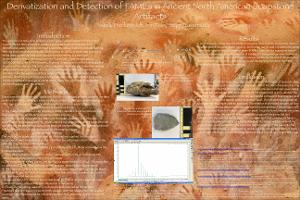Please use this identifier to cite or link to this item:
http://hdl.handle.net/10267/33570| Title: | Derivatization and Detection of FAMEs in Ancient North American Soapstone Artifacts |
| Authors: | Prodanovich, Natalie S. Carmody, Stephen |
| Advisors: | Russ, Jon L. |
| Keywords: | URCAS;Symposiums;Student research;2018 Spring;Class of 2018;Chemistry, Department of |
| Issue Date: | 27-Apr-2018 |
| Publisher: | Memphis, Tenn. : Rhodes College |
| Abstract: | Prior to the production of pottery 3000 years ago, humans would often carve large bowls out of rock, usually soapstone. Samples of such an artifact from the Thrash site, a Late Archaic period (3,000-1000B.P,) site in Pike Country, Alabama, have been subjected to a three step process for identifying fatty acids, the primary substance of foodstuffs. We used gas chromatography/mass spectroscopy (GC/MS) to analyze samples from the artifact along with samples of natural soapstone. The presence of different fatty acids can provide information about prehistoric dietary habits, whether from fish, mammals and/or plants. For the analysis, however, the fatty acids must be converted (derivatized) to fatty acid methyl esters (FAMEs). We used a method that converts triacylglycerides into FAMES in a one step process. These fatty acids will be correlated to a range of plants and animals that came into an extended period of contact with the artifact. |
| Description: | Presentation by Natalie Prodanovich ('18) and Stephen Carmody delivered at the Rhodes College Undergraduate Research and Creative Activity Symposium (URCAS). |
| URI: | http://hdl.handle.net/10267/33570 |
| Appears in Collections: | Undergraduate Research and Creative Activity Symposium |
Files in This Item:
| File | Description | Size | Format | |
|---|---|---|---|---|
| 201804_Prodanovich_Natalie_DerivatizationandDetectionofFAMEsinAncientNorthAmericanSoapstoneArtifacts_researchposter.pdf | 2.83 MB | Adobe PDF |  View/Open |
Items in DSpace are protected by copyright, with all rights reserved, unless otherwise indicated.